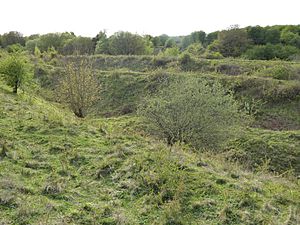Twywell Gullet facts for kids
| Site of Special Scientific Interest | |
 |
|
| Area of Search | Northamptonshire |
|---|---|
| Interest | Biological |
| Area | 17.1 hectares |
| Notification | 1989 |
| Location map | Magic Map |
Twywell Gullet is a special natural area in Northamptonshire, located east of Kettering. It covers about 17.1 hectares, which is roughly the size of 24 football fields! This site is officially known as a Site of Special Scientific Interest (SSSI) because of its important wildlife.
Twywell Gullet is part of a larger nature reserve called Twywell Hills and Dales, which is 54.6 hectares in total. This bigger reserve is looked after by groups like the Woodland Trust and the Rockingham Forest Trust. Long ago, this land was even part of the huge royal hunting area known as Rockingham Forest.
Contents
What is Twywell Gullet?
Twywell Gullet used to be a place where people dug for a mineral called ironstone. This digging created deep valleys with steep, sloping sides. Over time, nature has taken over these areas, turning them into a rich habitat for many plants and animals.
Amazing Habitats
The steep slopes of Twywell Gullet are now covered in beautiful limestone grassland. This type of grassland is special because it has many different kinds of plants growing there. At the bottom of the deep valleys, you'll find ponds and bushy areas, which provide even more places for wildlife to live.
Wildlife at Twywell Gullet
This nature reserve is a fantastic place to spot various creatures, especially insects and amphibians.
Insects and Bugs
Twywell Gullet is home to many interesting insects. You can find several types of rare bees and wasps that build their nests in the ground. There are also special beetles here. One very rare insect found at the site is the ruddy darter, which is a type of dragonfly.
Pond Life
The large pond at Twywell Gullet is a busy place. It has a big area of reeds, which are tall grass-like plants that grow in water. This pond is also home to many great crested newts. These newts are a protected species, meaning they are rare and need special care to survive.
Visiting Twywell Gullet
You can explore Twywell Gullet using the footpaths that go through the site. These paths let you see much of the beautiful scenery and wildlife. However, some areas with very steep slopes are not open to visitors to keep both people and the delicate habitats safe.

